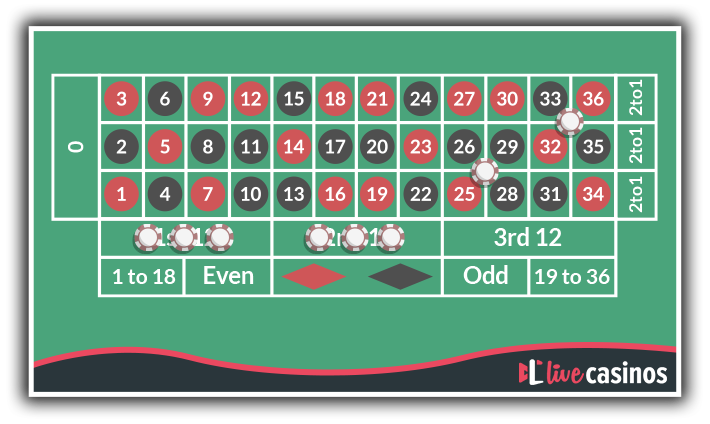Let’s look at roulette strategy from a different angle. By that, we mean that your main goal while playing should be to not lose. If you can guarantee that you’re at least at a net-zero, you can only go up from there, right?
Negative progression systems in roulette increase the size of your stake whenever you lose. The goal is to make up for any previous losses, while the winnings are pocketed as a profit. In theory, such strategies to win roulette are the opposite of positive progression systems.
In practice, negative progression is not without merit. We often point out that gambling beginners should focus on not losing first, and winning second. After all, playing live casino games online is all about having a good time. Not losing allows you to do that longer and without losing too much money. But such strategies also come with heavy risk.
Where positive progression has a small chance of working and winning big, negative progression has a small chance of not working and losing a lot. Again, we’ll use an example to see how negative progressions in roulette work. We’ll start with the (in)famous Martingale.
Martigale for Roulette
Like with all staking plans in roulette, using the Martingale for roulette comes down to repeating even money bets. Red/Black can work, as can Odd/Even or High/Low.
In Martingale, you start by placing a bet with a small starting stake – let’s say $10 for convenience sake. If you win, you take the money and make the exact same bet again. If you lose, you double the stake to $20 and bet again. This doubled bet can then make up the bet you just lost you’ll earn $20 in profits, after all. Any winning bets remain as pure profit, too. The idea is that even if you keep losing, you’ll eventually make up losses.
The problem with the Martingale strategy in roulette kicks in if you hit a losing streak. You have to double the stake again, and again, and again. Eventually you’ll simply run out of money to cover the expanses and lose everything.
The Martingale doesn’t work because of its exponential losses. $10 turns into $20, which turns into $40, and $80, then $160, and you’re already down $310. And remember, this is just 5 unfortunate losses and you were originally hoping to win $10. In short, the Martingale would work if you had an infinite budget and an infinite amount of time. No one does, so you’re playing with fire.
Alternatives
To counteract this issue, players developed more conservative negative progression roulette systems. These are somewhat less likely to work as a roulette strategy to win real money. They’re also less likely to leave you bankrupt, though.
- The Fibonacci system increases the stake every time you lose, using the sum of the previous two stakes. For example, if you lose two consecutive $10 bets, only then do you increase it to $20. The next loss bumps this up to $30, and so on. It’s a lot less risky than the Martingale. However, your losses are not completely reversed either. As a result, the Fibonacci keeps potential losses consistent, but more manageable.
- D’Lambert splits your bankroll into equal units, and the stake is increased by +1 unit every time you lose. It has the same advantages and disadvantages as the Fibonacci, only more pronounced.
- The Laboucherre system in roulette is a more complicated system that adjusts the progression based on the context. It’s arguably the most advanced of all negative progression strategies in roulette and does the best job at countering the negatives.
As always, negative progression is not a guaranteed strategy to win roulette. There is no such thing. However, we can again learn some lessons from it.
- Protecting yourself from losses can be more valuable than chasing profits.
- Adjusting the stake to fit the current state of your stake is essential.
- Knowing when to quit is important because gambling losses can be exponential.
Flat Betting in Roulette
The third type of wagering system for roulette is both the simplest and arguably most “honest.” We would venture so far as to call it a proven roulette system because it doesn’t promise anything it can’t deliver. Flat betting is an incredibly simple notion – you just wager the same amount every time. Why is this even considered a winning roulette strategy, then?
The flat betting system in roulette allows you to do more with a single round than bet on even money every round. It also doesn’t allow for a Risk of Ruin like the Martingale. Sounds interesting? Let’s explain through a great example – the Romanosky.
The Romanosky Bet in Roulette
The Romanosky takes full advantage of the fact that its stake is always the same. How? By covering as much of the table as possible for a maximum probability of winning.
The Romanosky betting system makes four separate wagers each round: two Dozen bets and two Corners. First of all, you need to split your stake into 8 units of the same size. Then, place them in the following way.

- 3 units on the 1st Dozen bet
- 3 units on the 2nd Dozen bet
- 1 Unit on the 25/29 Corner
- 1 Unit on the 32/36 Corner
Note that you can actually combine any two Dozen bets with any two Corner bets. As long as the Corner bets cover the third of the table that the Dozens don’t, you’re good to go.
This means that over 86% of all possible outcomes win. Only 5 numbers on the wheel don’t win. If a Dozen bet wins, you win 9 units in total. If a Corner wins, you also win 9 units. That leaves you with a high likelihood of a small profit every round.
The problem with Romanosky is that one lost round takes 8 winning rounds to make up. With an 86% chance of success, though, that’s not difficult to achieve.
Final Thoughts
The age-old game of roulette was carefully constructed to always have the same chance of winning. No matter which bet or strategy for roulette you use, this fact does not change. Believing otherwise is a common misconception among players new to roulette.
However, systems and staking plans allow you to keep closer tabs on your spending and earnings. While a system in roulette strategy won’t win for sure, there are major advantages to sticking to a plan. Ultimately, though, the best roulette strategy to play with is bankroll management. Don’t spend more than you can afford, and you’ll do fine.
Want to test out your new understanding of live roulette systems? Check out these top-notch casinos.









































 Roulette
Roulette
 Blackjack
Blackjack
 Baccarat
Baccarat
 Poker
Poker
 Sic Bo
Sic Bo
 Dragon Tiger
Dragon Tiger
 Game Shows
Game Shows  Top 5 Games
Top 5 Games  See more
See more  Roulette Casinos
Roulette Casinos  Low Limit
Low Limit  High Limit / VIP
High Limit / VIP  Exclusive
Exclusive  How to Play
How to Play  Basic Strategy
Basic Strategy  Top Tips
Top Tips  FAQ
FAQ  Blackjack Casinos
Blackjack Casinos  Baccarat Casinos
Baccarat Casinos  Bonuses
Bonuses  Poker Casinos
Poker Casinos  Game Providers
Game Providers  Sic Bo Casinos
Sic Bo Casinos  Dragon Tiger Casinos
Dragon Tiger Casinos  Credit and Debit Card
Credit and Debit Card  e-Wallet
e-Wallet  Cryptocurrency
Cryptocurrency  Bank and Checks
Bank and Checks  Pay by Phone and SMS
Pay by Phone and SMS  See more
See more  How-To Guides
How-To Guides  Top Lists
Top Lists  In-Depth
In-Depth  Strategy
Strategy  Casino & Games
Casino & Games  Insight
Insight  News
News  Promotions
Promotions 
 Guide to Live Casinos
Guide to Live Casinos  Top 10 Live Casino Tips
Top 10 Live Casino Tips  Studio Locations
Studio Locations  FAQ & Help
FAQ & Help  Meet The Dealers
Meet The Dealers  Our Awards
Our Awards  How We Rate
How We Rate  Responsible Gambling
Responsible Gambling 




























 ENG
ENG 







 Facebook
Facebook
 Pinterest
Pinterest
 Twitter
Twitter
 LinkedIn
LinkedIn
 Copy Link
Copy Link 





















